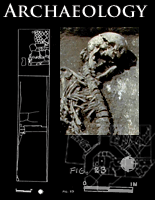
Evidence for Reconstructing Monasticism
Monastic churches, and sometimes the monastic buildings around the cloister, have traditionally been the domain of art and architectural historians. In contrast, monastic texts — chronicles, customaries, cartularies, etc. — have been studied primarily by historians. Archaeological evidence ranging from identified floor levels to pot shards and human skeletal remains have really only become part of the evidence base for monasticism over the last quarter century and have been little used by historians or art historians.
This web site aims at integrating — and at giving the scholar or student the opportunity to integrate — these three different bodies of evidence (architecture, text and material culture). We see the three types of evidence as providing "parallel calibrations" for dating and for interpretation. The scholar may begin with pottery excavated in the cloister and move from there to that architectural space or to the customary passage describing its functions. The ultimate goal is to give the scholar or student a full array of tools with which to understand the nature of monastic life without privileging one type of evidence.







 This web site was supported by a grant from the National Endowment for the Humanities.
This web site was supported by a grant from the National Endowment for the Humanities.